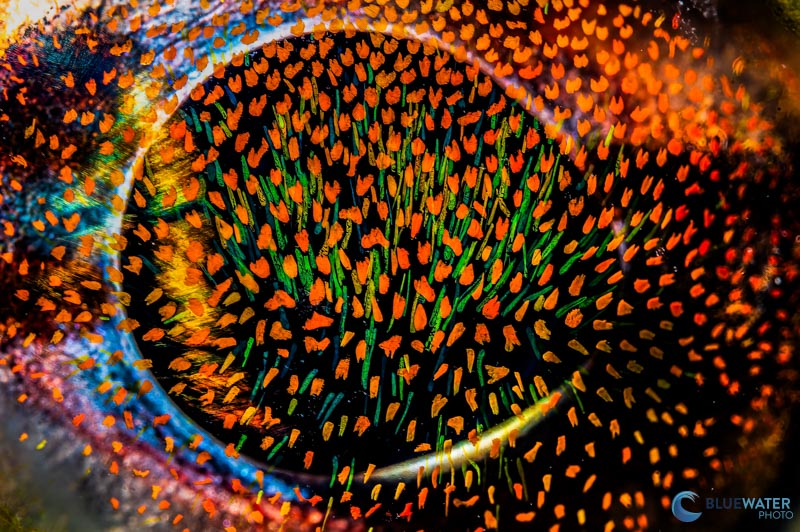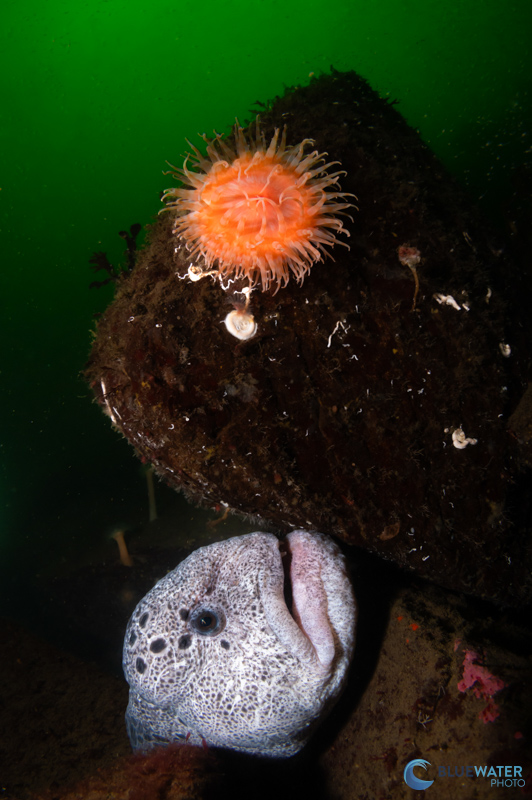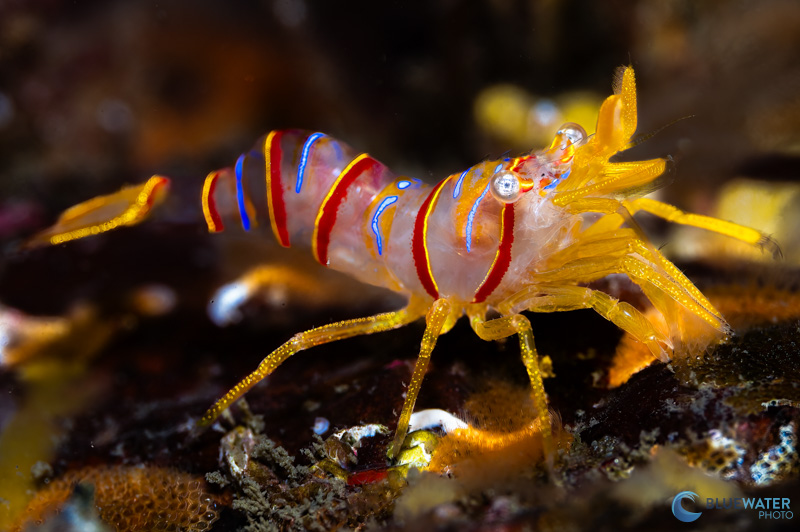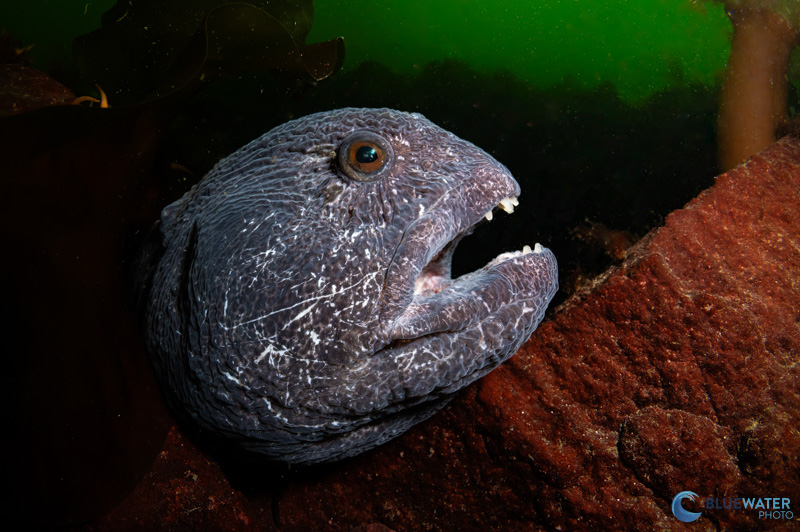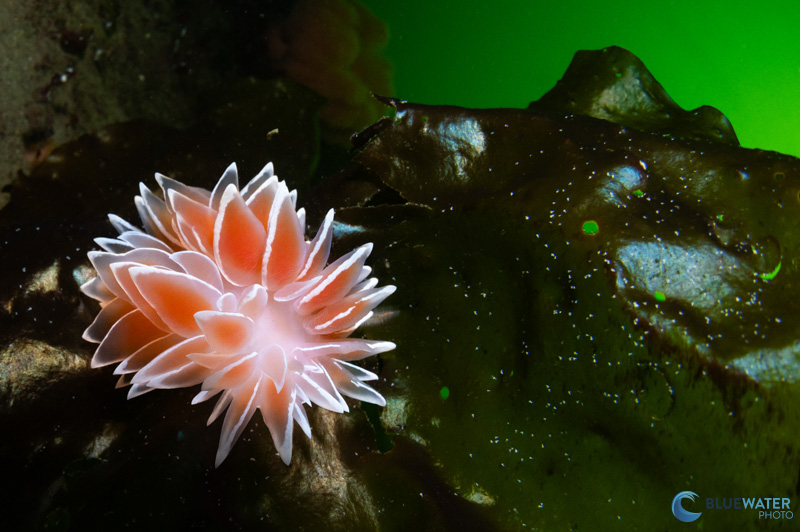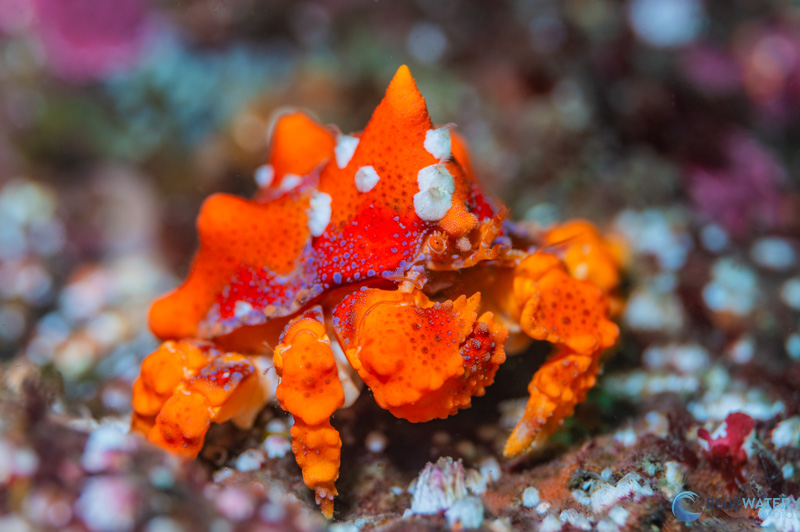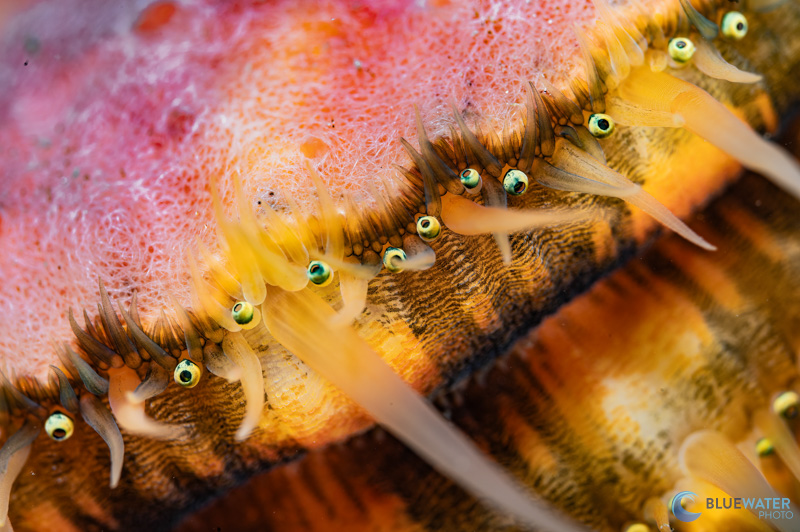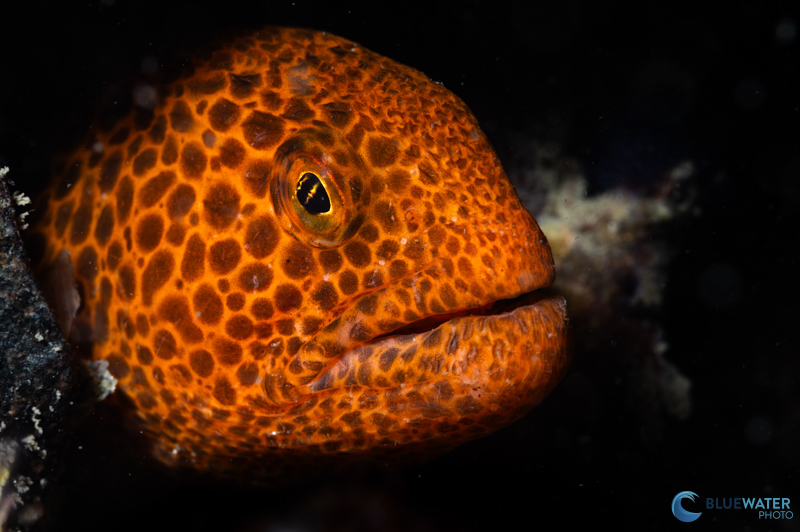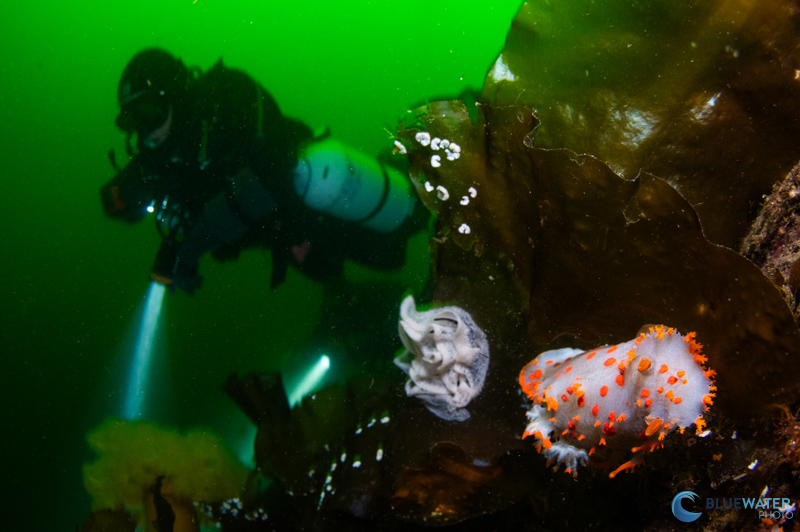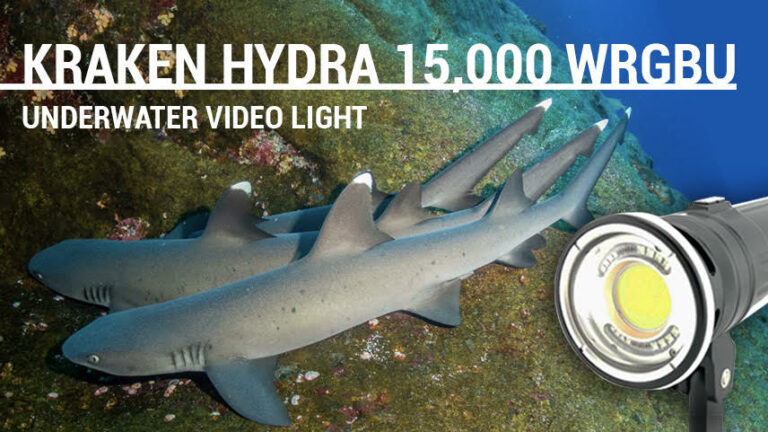
If you read the Underwater Photography Guide, then you know we love Kraken. We love their lights, their monitors, their lenses, and everything in between. But you may have also noticed that one of our slightly less glowing reviews was the original Kraken Strobe. Although this strobe featured excellent recycle times and long battery life, it did not produce a wide enough beam for underwater photography…. fast forward five years and the new Kraken KS-160 strobe is complete redesign of the original Kraken strobe concept. This new and very much improved strobe features a powerful 160 Ws output, a 120 degree beam angle (without diffusers), 5500k color temperature, and a recycle time of 1.6 seconds at full power. At lower powers, you can expect a battery life of thousands of flashes and recycle times that can easily keep up with 5 fps of shooting.
We were lucky enough to dive with the first Kraken KS-160 strobe prototype in the cold, dark waters of the Pacific Northwest. Even after just a few dives, it’s safe to say that Kraken has introduced a formidable competitor to some of the top strobes on the market – especially with the $850 price point at Bluewater Photo.
The Kraken KS-160 Strobe is Available at Bluewater Photo!
Order the Kraken KS-160 Strobe
Kraken KS-160 Strobe Specifications
- 160 Ws of output at highest power
- 400 shots per charge at full power
- 120 degree beam angle without diffusersA 5500K color temperature
- Circular flash tube
- 1.6 second recycle time at full power
- 500 lumen LED modeling light
- No TTL
- 5 pin sync and fiber optic strobe triggering
- Slave mode with a slave sensor
- Dedicated battery pack (2x 21700 with USB-C charger
- Anodized aluminum construction
- Depth rating: 300 ft (100 meters)
- Dimensions: 3.3″ x 3.9″ x 7.6″
- Weight: 1210g in air and 300 grams underwater
Kraken KS-160 Strobe Key Features
An High Quality Beam
Beam quality is the standout feature of the Kraken KS-160 strobe. With a cooler color temperature of 5500 K, it is reminiscent of the Sea & Sea YS-D3, and the wide 120 degree beam angle produced by a circular flash tube is quite similar to the Ikelite DS 230.
Color Temperature
I personally found that the cooler color temperature of the beam was ideal for the greener waters of the Pacific Northwest. Cool light from a strobe and green mixes quite nicely. I often like warmer color temperature strobes for bluer water where a lightroom white balance correction pushes both the warmer subject and background color towards blue. However, I like colder strobes for macro photography where the color of the substrate does not look too warm. It helps bring out the true colors of the subject as you can see in the photo below.
Beam Angle
The wide, 120 degree beam on the KS-160 is just right for wide angle photography – even without using a diffuser. I find that this beam angle reduces backscatter, but still covers the full scene that you are trying to shoot – even if you need to use just one strobe. Of course, I prefered having two strobes for creative lighting effects. For most of my wide angle photography in the Pacific Northwest, I kept the diffusers off the strobe to reduce backscatter in the murky, dirty water.
The KS-160 quickly became one of my favorite strobes on the market for wide angle photography, as the circular flash tube encourages diffuse lighting in your photos without hotspots and diffuse (not hard) edges in the frame.
Power
The max output of the Kraken KS-160 strobe is 160 Ws. So how powerful is 160Ws anyway? 160 Ws, or watt-seconds, is powerful enough for most wide angle photography where you need to have a lot of strobe power to match powerful ambient light in clear, bright conditions. In the dark conditions of the Pacific Northwest, I only needed to set the strobes to 10% power for most of my photography, allowing me to shoot with very quick recycle times! In tropical wide angle situations in shallow water, I would need to shoot at higher powers.
Fast and Consistant Strobe Recycling
At full power the Kraken KS-160 strobe has a 1.6 second recycle time. I found this to be the case during my dives, though I rarely used the strobes at max output. I tested the strobes at half power in a soon to be released video, topside, and found that the strobes were able to recycle much faster – about 6-10 flashes per second. What’s more, at lower powers, the KS-160s have consistantly the same output with each flash. This is even the case with very fast recyle times. This gives the photographer an extra dose of reliability as you can expect each shot to have consistantly the same power, unlike many other strobes on the market.
Long Battery Life
The battery life of the KS-160 is 400 shots at full power. Of course, most people don’t need to shoot 400 full dumps in a row. With normal use, I estimate that battery life is closer to 600 or 700 shots. I was easily able to do a full day of diving (three dives) with the modeling lights on the whole time, as I forgot my dive light. Most divers should be able to get through a day of diving and recahrge their strobes at the end of the day through an easy-to-charge usb-c compatible battery.
Durable Construction
The Kraken KS-160 strobe is constructed from an anodized aluminum body. With heavy winds and current, I put my strobes through a lot. The anodization was only lightly scratched despite multiple dives through surf over rock and pebbles. The strobes are built like a tank and should not have any problems with diving in any conditions.
A Weight Concern and Solution
There is a problem with being built like a tank….these strobes are heavy. This is the primary downside of the Kraken KS-160s. At 300 grams underwater, they are lighter below the waves than above (1.2 kg). That said, they were still quite heavy. I reached out to Kraken about my concerns, and thankfully they have responsed with a promising solution – attachable floats! As long as you use float arms or attach floats to the strobes themselves, it should solve the weight issue.
LCD Panel and Power Control
The LCD panel on the strobes is a very nice touch. The KS-160 can show you the power setting on the strobe as well as how many shots you have left at your current power level. It’s nice not needing to guess how much battery life you have on your strobes while you are shooting, so you can plan your shoot ahead of time.
The power dial on the back panel sticks out quite far which makes it very easy to turn and manipulate in cold water with the thickest gloves. In fact, this is my favorite strobe dial of any strobe on the market.

Flash Triggering, Slave, and (No) TTL
The Kraken KS-160 is very versatile when it comes to triggering methods. It is compatible with Sea & Sea style fiber optic cables, which will probably be the most popular connection method. For those that are looking at their first strobe – a fiber optic cable allows you to fire your strobe from your camera via the camera flash or flash trigger. It does not penetrate the strobe or housing, which makes it resistant to flooding.
For old school photographers, Ikelite shooters, and those who want an ultra-fast recycle time, the KS-160 supports 5-pin sync cords. This is the same kind of sync cord connection used by Sea & Sea and Inon strobes.
Finally, for those looking to trigger your strobes remotely, the KS-160s do have an optical sensor that can be used as a slave and triggered by another strobe. I actually had only a single sync cord during my dives, and triggered the second strobe via slave the whole day of diving. It worked great, as long as the optical sensor was within site from the primary strobe. I would expect the max distance for triggering to be about a meter.
For those that are wondering, the KS-160 does not have TTL circuitry on board. TTL is the ability of the camera to communicate to the strobe what powerlevel it needs to fire at with the camera’s current settings. It’s basically “automatic” strobe power. Although it’s a nice feature, the KS-160 is very easy to operate manually. We’ve noticed that many new strobes announced in 2023 are do not have TTL circuitry.
Who Should Buy the Kraken KS-160 Strobe?
The Kraken KS-160s are designed for photographers who need a pro-level strobe for an affordable price point. It’s a powerhouse for both wide angle and macro photography. Other 160 Ws strobes are typically priced about $200 – 500 more than the KS-160. When it comes to beam quality, recycle time, and batterylife, the KS-160 definitely measures up to, and in some cases surpases, these strobes. With its size, I might not recommend the KS-160 for compact camera shooters, but I certainly would for MFT, APS-C, and full frame shooters.
On a side note, I personally very much enjoyed using the KS-160s for cold water diving. This is because I was able to manually reduce the power to about 5%, allowing me to shoot at extremely high ISOs like 1250. This allowed me to get a little bit of strobe power on my subject while being able to get green ambient light in my backgrounds in conditions that almost resembled night dives.
Conclusions
The Kraken KS-160 strobe is the first strobe made by Kraken that can easily compete with some of the top strobes on the market. Much like the Scubalamp D-Pro, it represents pro-level quality for a more affordable price point than other strobes on the market. The beam quality, recylce time, and battery life are all more than adequate for wide angle shooter and macro shooters that need to shoot the quickest subjects. Although the weight of the strobe is a concern, it’s very much addressable with float arms and newer floats being designed for the strobe. At the end of DEMA 2023, Doug asked me if I wished to keep the strobe so that I could shoot it longer. You can bet that I did!



